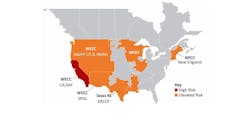Taking Charge of Electrical Sourcing and Consumption
The cost of energy is among the largest expenses for any foundry. Very few of these operations have staff dedicated to managing energy-related expenses. The purpose of this column is to help you optimize your energy expenses and improve your profitability. Want to save money on your electric bill? This column is for you.
Often it is much easier to find $100,000 in energy savings than it is to get equivalent revenue from increased sales. If your average net profit is 5%, how much additional sales will it take to generate $100,000 of profit? Usually, energy savings offer the additional benefit of recurring every month.
The focus of this column is to help foundry managers identify aspects of cost-saving and optimization in energy supply and usage that are worth investigating, and to offer resources and technology to meet the needs of foundries.
The energy sector is changing, rapidly. Until recently, we could expect few outages and relatively stable prices for our energy needs. Not too many surprises in our monthly bills. However, as we have seen recently in Texas and California, that is no longer the case. In its Summer 2021 Reliability Assessment, the North American Energy Reliability Council (NERC) provides an evaluation of the resource and transmission system adequacy that is necessary to meet projected summer peak demands.In addition to assessing resource adequacy, the SRA monitors and identifies potential reliability issues of interest and regional topics of concern. The findings represent NERC’s independent evaluation of electric generation and transmission capacity, as well as potential operational concerns that may need to be addressed for the upcoming summer.
Parts of North America are at elevated risk of energy emergencies (see Figure 1.) Above-normal heat in summer can challenge grid operators by increasing demand from temperature dependent loads (such as air-conditioning and refrigeration) and reducing electricity supplies, as a result of lower-than-capacity resource output or increased outages. Wide-area heat events (such as the August 2020 heat wave that affected much of the Western United States and Mexico) are especially challenging, as fewer resources are available for electricity transfers between areas because they are required to serve native load.
There are many reasons behind this rather ominous assessment, none of which you control. However, it can serve to increase your awareness and preparations to do what you can to counter the possibility. For many foundries, there are a number of things that can be done.
First and foremost, senior managers should take the lead on initiating, authorizing, and prioritizing energy-related initiatives. Make it known how important energy-cost control is to the whole organization. Set objectives and encourage innovative solutions. Measure and reward successful initiatives.
The management of several different foundries took a common approach to reducing their costs. They simply announced that each facility was expected to reduce energy expenses by 15% for the next fiscal year. Each facility was expected to determine where to gain the savings. You might consider establishing a broader initiative and support, such as encouraging sharing of successful projects among facilities, establishing incentives, budgeting additional resources, etc.
A wide variety of specialized products and services are available to help optimize your energy costs. Many of these have a rapid return on investment. Indeed, some products are offered as a service, with no up-front capital cost. Vendors of these products prepare a no-obligation proposal for your review. We work with many such vendors and are aware of their capabilities.
We have been helping foundries identify energy-saving opportunities for over 12 years. In future columns we’ll focus on things we have learned that may benefit your foundry. In general, the focus will be on:
• Securing energy supply at the most reasonable cost;
• Limiting exposure to price changes;
• Maximizing production by improving energy availability; and,
• Using less energy and/or improving energy efficiency.
Many aspects of the energy sector are incredibly complex but managing your costs does not have to be. You don’t need to be an energy expert. What you may need is a roadmap of potential areas to explore and the possible savings to be found. Perhaps bring in some subject matter expert assistance. We’ll help you develop that roadmap. You can focus on assessing your options and making a decision.
Next month we’ll start with a review of some things to investigate that are not even part of your physical operations but are good to investigate in any case.
We want this column to be a clearinghouse of energy-related information from foundries willing to share their experiences. Those examples – even anonymous ones – are invaluable to other metalcasters.
Brian Reinke, president of TDI Consulting, is an energy-cost saving consultant. Contact him contact him at [email protected].
About the Author
Brian Reinke
President
Brian Reinke, president of TDI Energy Solutions, is an energy-cost saving consultant. Contact him at 630-343-0971.

